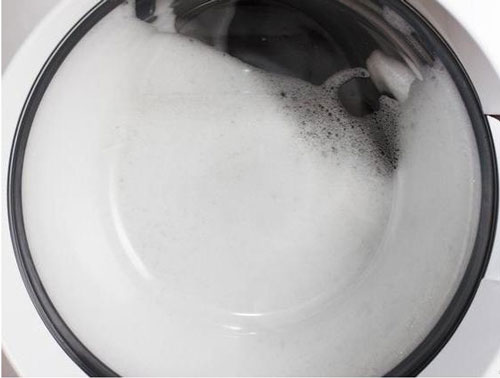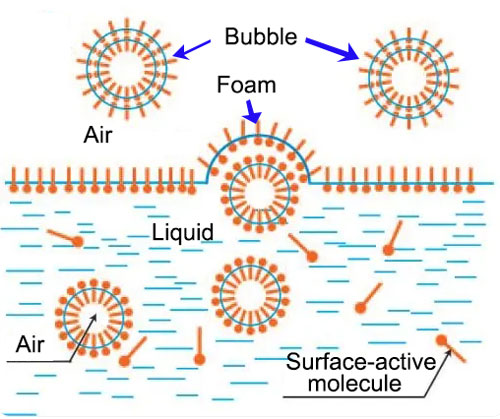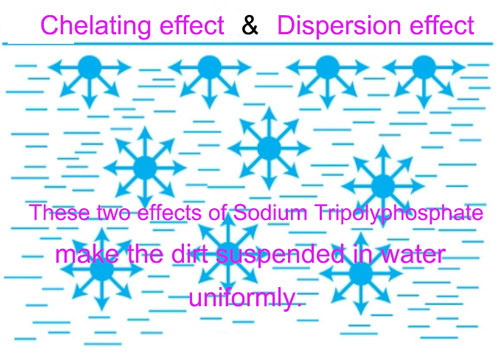No, Sodium tripolyphosphate itself doesn’t generate foam in water.

I. Introduction of sodium tripolyphosphate
Sodium tripolyphosphate is an inorganic compound with the chemical formula Na5P3O10, usually appearing as a white crystalline powder that forms an alkaline solution (pH 9.7) when dissolved in water. Sodium tripolyphosphate uses are many, mainly in food, detergents and other industries as a quality improver, moisture retainer, pH regulator, and metal chelator.
In detergents, it is used as a washing aid to enhance the washing effect.
In practice, some products containing sodium tripolyphosphate may produce foam, but this is not caused by sodium tripolyphosphate itself. Other ingredients with foaming function, such as surfactants, foaming agents, etc., may be added to these products, and these ingredients work together with sodium tripolyphosphate to enhance the washing effect at one time.
II. Mechanisms of bubble creation
Foaming is a phenomenon in which air enters and is evenly distributed in a liquid during mixing and blending. Surface-active substances, such as proteins and fats, are usually needed to reduce the surface tension of the liquid, making it easier for air to enter the liquid and form bubbles.

However, sodium tripolyphosphate does not have the properties of these surface-active substances, and its main function is to act as a chelating agent that combines with metal ions to form stable compounds, preventing the metal ions from negatively affecting the quality of the wash.
III. High foaming doesn’t equal good washing effect
Many laundry detergent ads promote their products by highlighting the foaming characteristics of the laundry as a way to show that the laundry is very effective. But this is not the case.
Soap appeared in the late 17th century, it has wetting, emulsifying, foaming, solubilizing, suspending and other properties in water, showing significant effectiveness in removing dirt. But then the soap can not be in hard water (refers to the water containing more soluble calcium and magnesium compounds) in the use of hard water, because the hard water calcium and magnesium ions can make the soap to lose the ability to wash, but also in the formation of fabrics on the calcium soap and magnesium soap and thus make the fabrics yellow, gray.

IV. Advantage of using sodium tripolyphosphate while doing laundry
Either adding sodium tripolyphosphate into the soap or adding it into the water, can chelate calcium and magnesium ions within hard water, so that the soap can also have a good washing effect in hard water.
In addition, sodium tripolyphosphate can improve the suspension ability of dirt, preventing the dirt from being re-deposited onto the fabric. In synthetic detergents, in addition to surfactants, sodium tripolyphosphate, it is also necessary to add some organic and inorganic washing auxiliary ingredients according to a certain combination of formulas, such as fluorescent whitening agents, organic auxiliaries, inorganic auxiliaries, enzymes, and so on.

IV. Conclusion
Sodium tripolyphosphate does not possess foaming properties by itself. It is hygroscopic, soluble in water and alkaline in aqueous solution. Whether in water, in solution, or in air, its hydrate is hexahydrate. In applications in food, detergents and other industrial fields, it mainly acts as a chelating agent to improve product quality and performance. Although foam generation may be observed in some products containing sodium tripolyphosphate, this is not caused by the sodium tripolyphosphate itself, but rather by the surfactant. With the creation of modern detergents, detergent foam is gradually losing its original meaning. Many people want rich detergent foam, and this is largely psychological, as the foam gives the impression that the detergent has survived. This is similar to the misconception that thicker detergents are more concentrated and thinner detergents are less concentrated. In fact, the relationship between foam and detergent detergency is not a definite one.
Related blog:

